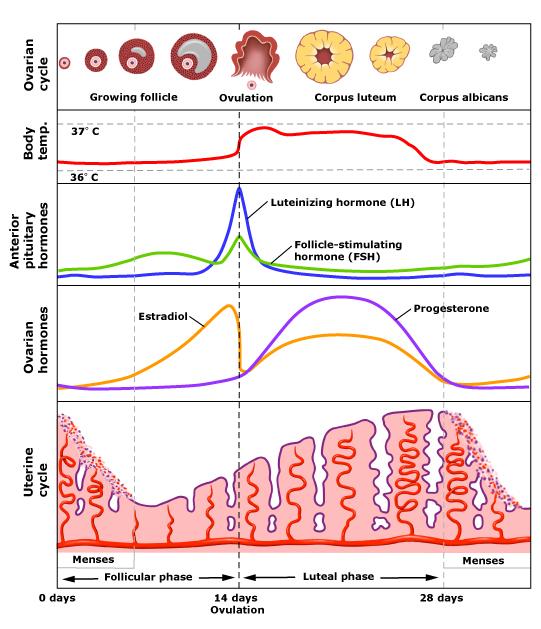The items of menstrual history include the following items in sequence:
- [1] Menarche- it is the 1st menses in the woman's life. Normal age is between 9-16.
Precocious puberty: earlier than 9 years old
Delayed puberty: later than 16 years old
- [2] Cycle rhythm- whether the menses occur in regular or irregular period of time.
- [3] Cycle length- it is the duration from 1st day to the next 1st day of menses cycle. Normal cycle length ranges from 21 to 35 days.
<21 days - polymenorrhea
>35 days - oligomenorrhea
- [4] Duration of menstrual flow- It is the period of time during which the menstrual blood flow through the vagina. Normal duration of menstrual flow ranges from 2-7 days.
Menorrhagia: prolonged >7 days and/or 80cc occurring at regular intervals = hypermenorrhoea
Metrorrhagia: irregular uterine bleeding not related to menstruation
Menometrorrhagia: prolonged uterine bleeding occurring at irregular intervals
Polymenorrhagia: frequent heavy/ prolonged menstruation
Postmenopausal bleeding: irregular vaginal bleeding following menopausal cessation of menstruation by 1 year
Intermenstrual bleeding: irregular vaginal bleeding in between regular normal menstruation = breakthrough bleeding
Contact bleeding: irregular vaginal bleeding following tissue contact (examination/intercourse)
- [5] Character of flow- it is regarding the amount, colour and odour of the blood. Normal amount is not more than 80 ml of the total volume. Normal colour of mense blood is dark red.
Excessive flow- indicated by present of clots
Bright red- may indicate excessive flow especially if associated with clots
Polymenorrhea: frequent menstruation occurring at regular intervals (<21 days)
Oligomenorrhoea: infrequent menstruation varying between 35 days and 6 months
Hypomenorrhoea: scanty regular menstruation (<20 ml)
Amenorrhoea: absence of menses for 3 successive regular cycles or 6 months
- [6] Dysmenorrhea- It is pain related to menses. It is severe enough to prevent the woman from doing her daily activities. Dysmenorrhea may be primary or secondary. The tolerable pain at menses is called 'menstrual molimina'.
Primary (spasmodic) dysmenorrhoea
Secondary (congestive) dysmenorrhoea
Special types of dysmenorrhoea
- [7] Intermenstrual Period (IMP)- It is the period from the last day of flow to the next 1st day of flow. Abnormal pain, bleeding or discharge may be presence or absence.
Normally ovulation may cause pain (Mittleschmerz's pain), bleeding (ovulation spotting) or increase of vaginal discharge (ovulation cascade).
- [8] Last Normal Menstrual Period (LNMP)- The 1st day of the last normal menstrual period should be asked for. To certain that the last menstrual period was normal it should fulfill the following criteria:
- It should be normal characters
- It should be preceded by 3 consecutive normal cycles
- It should not be preceded by the use of hormonal contraceptive
NB- The expected date of delivery (EDD) is calculated & mentioned before.
- [9] Current use of contraceptive- It should be mentioned here if it is currently used. The type of contraceptive method and the duration of its use should be asked.


.png)




0 comments:
Post a Comment